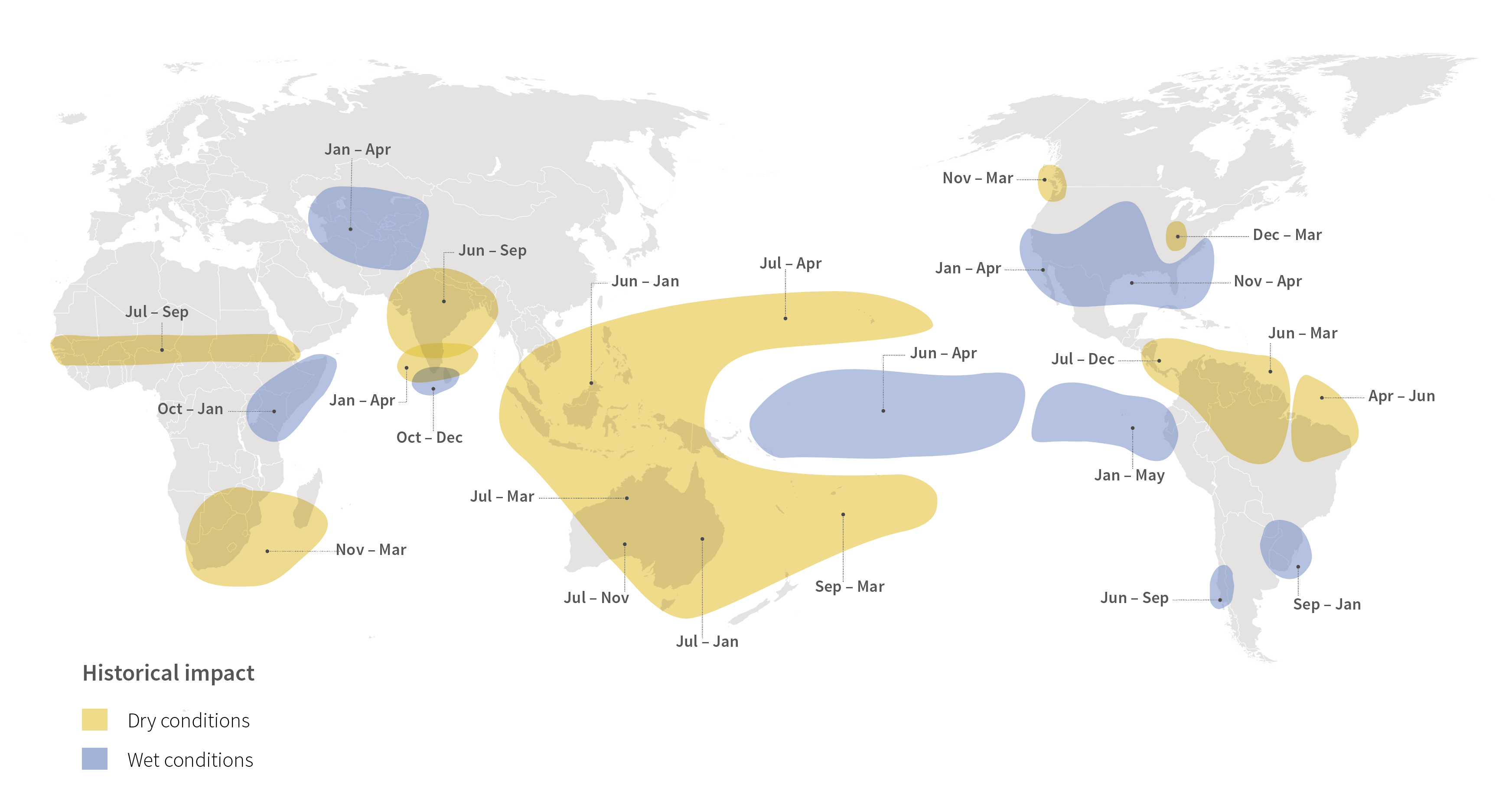Historical El Niño trends

In parts of Southeast Asia, El Niño typically results in below-normal rainfall, especially during the height of the monsoon season (June-September) in much of South Asia. The phenomenon may also bring drier weather in some of the Pacific islands, threatening food and water shortages. Meanwhile, in Central Asia it’s usually associated with above-average rainfall, which can trigger floods and landslides, washing away seeds and destroying crops and livestock.
El Niño has generally brought above-average rainfall between October and December in the Horn of Africa. This can cause flooding and landslides, impacting agriculture and increasing the risk of disease. Below-average rainfall is observed in the western unimodal parts of East Africa (western Ethiopia, Sudan, South Sudan, Uganda, western Kenya) between July and September. Across most of southern Africa, there has been reduced rainfall attributed to El Niño between November and March in past years, coinciding with the main cropping season. This could impact crop prospects and livestock productivity, exacerbating the situation in countries facing domestic food supply challenges and high levels of food insecurity. In West Africa and the Sahel, El Niño has historically brought below-average rainfall conditions between July and September, coinciding with the main agricultural season. This could worsen the situation in countries facing domestic food supply challenges and increasing reliance on imports amid high global food prices.
In the northern part of South America, El Niño results in below-average rainfall between June and the following March. In Central America, particularly in the Dry Corridor, El Niño is associated with dry conditions between June and December, potentially affecting the end of the primera season and the performance of the postrera season between September and December. The primera is the main season for maize and agricultural season in general in most of the countries in the region.
Latest news

El Niño: FAO’s updated Anticipatory Action and Response Plan urgently requires $160 million to support over 4.8 million people through March 2024
Prioritized actions in 34 countries across Eastern and Southern Africa, Asia and the Pacific and Latin America and the Caribbean.

News
FAO and UK launch anticipatory action to reduce El Niño’s impact on at-risk communities in Somalia
From the FAO Regional Office for Africa


News
Increasing risk of hunger set to spread in hotspot areas as the Sudan crisis spills over into subregion and el Niño looms - warns new UN report
Burkina Faso, Haiti, Mali and the Sudan have been elevated to the highest alert level to join Afghanistan, Nigeria, Somalia, South Sudan and Yemen
Key publications
.png?sfvrsn=8564e438_1)
Anticipating El Niño: Mitigation, preparedness and response plan for Southern Africa, 2023–2025
El Niño poses a serious threat to the food security and survival of vulnerable communities around the world.
.png?sfvrsn=b84f396c_11)
Publication
El Niño: Anticipatory Action and Response Plan, October 2023–March 2024
Mitigating the expected impacts of El Niño-induced climate extremes on agriculture and food security

Publication
El Niño: Anticipatory Action and Response Plan, August–December 2023
Mitigating the expected impacts of El Niño-induced climate extremes on agriculture and food security.

Publication
Understanding the drought impact of El Niño on the global agricultural areas
An assessment using FAO’s Agricultural Stress Index (ASI).
Multimedia
Video
Michel Jarraud discusses El Niño
Secretary-General Emeritus of the WMO explains how El Niño forms and the impact it has on food production and security all over the world.
Anticipatory Action in Timor-Leste: Bracing for Drought
As Timor-Leste shows signs of drought linked to El Niño, fears of food shortages are growing.



.jpg?sfvrsn=c41219d1_13)